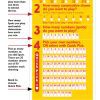Are you wondering how to choose the right poker strategy to up your game? Well, you’ve come to the right place! Let’s dive into the exciting world of poker strategies and learn how to navigate the tables with confidence.
When it comes to poker, having a solid strategy is key. But with so many different approaches out there, how do you know which one is right for you? Don’t worry, we’ve got your back! In this article, we’ll explore various factors to consider when selecting a poker strategy that suits your style and maximizes your chances of success.
So, whether you’re a seasoned player looking to fine-tune your skills or a beginner just starting out, join us as we uncover the secrets of choosing the perfect poker strategy for your game. Get ready to take your poker skills to the next level and outsmart your opponents at every turn. Let’s get started!
1. Understand your playing style and preferences.
2. Research and learn about different poker strategies.
3. Consider your bankroll and risk tolerance.
4. Practice and refine your chosen strategy.
5. Stay adaptable and willing to adjust your strategy as needed.
Finding the right poker strategy is crucial for success. Follow these steps to choose the strategy that suits you best!

How Do I Choose the Right Poker Strategy?
Choosing the right poker strategy can greatly influence your success in the game. Whether you’re a beginner or an experienced player, having a solid strategy is essential for maximizing your chances of winning. But with so many different strategies out there, how do you know which one is right for you? In this article, we’ll explore the key factors to consider when choosing a poker strategy, as well as provide tips and insights to help you make an informed decision.
Evaluating Your Skill Level
One of the first things to consider when choosing a poker strategy is your own skill level. Are you a beginner looking to learn the basics, or are you an experienced player looking to take your game to the next level? Different strategies cater to different skill levels, so it’s important to assess where you currently stand. If you’re new to poker, starting with a simple and straightforward strategy will help you develop a strong foundation. On the other hand, if you’re more advanced, you may want to explore more complex strategies that involve advanced concepts and tactics.
It’s also important to note that even experienced players can benefit from revisiting the basics and refining their fundamental skills. Taking the time to assess your skill level honestly will allow you to choose a strategy that aligns with your abilities and goals.
Understanding Your Playing Style
Another crucial factor in choosing the right poker strategy is understanding your own playing style. Are you an aggressive player who likes to take risks and make bold moves, or are you more cautious and prefer to play it safe? Your style of play will determine the type of strategy that suits you best.
For aggressive players, a strategy that focuses on exploiting opponents’ weaknesses and making calculated bluffs may be the way to go. On the other hand, if you’re more risk-averse, a strategy that emphasizes patience, discipline, and tight play may be a better fit. Remember, there is no one-size-fits-all approach when it comes to poker strategies. Your strategy should reflect your personality and preferences as a player.
Another aspect of playing style to consider is your ability to read and analyze other players. If you have a strong knack for reading opponents and picking up on their tendencies, a strategy that incorporates psychological elements and mind games might be a good choice. Alternatively, if you struggle with reading players, a more mathematically-oriented strategy that relies on odds and probabilities could be a better fit.
Bankroll Management and Risk Tolerance
Bankroll management is a crucial aspect of poker strategy that often goes overlooked. Before deciding on a strategy, it’s important to consider your bankroll and your risk tolerance. Your bankroll is the amount of money you have set aside specifically for poker, and it dictates the stakes you can comfortably play. Your risk tolerance, on the other hand, is your willingness to take on higher stakes and potential losses.
If you have a small bankroll or a low risk tolerance, it’s generally recommended to choose a strategy that focuses on playing conservative and low-risk poker. This will help protect your bankroll and minimize the potential for significant losses. Conversely, if you have a large bankroll and a high risk tolerance, you may be more inclined to choose a strategy that involves more aggressive play and higher stakes.
Ultimately, the right poker strategy for you will depend on your individual circumstances, goals, and preferences. Taking the time to evaluate your skill level, playing style, and bankroll management considerations will help you make an informed decision. Remember, poker is a game of skill, strategy, and adaptability, so don’t be afraid to experiment and refine your approach as you progress in your poker journey.
Common Poker Strategies and Their Pros and Cons
While there are countless poker strategies out there, certain approaches have gained popularity and proven to be effective for many players. In this section, we’ll explore some commonly used poker strategies, outlining their key characteristics, benefits, and potential drawbacks.
The Tight-Aggressive Strategy: Playing it Safe and Selective
The tight-aggressive strategy is one of the most popular and widely recommended approaches in poker. It involves playing a relatively small range of strong hands preflop and being aggressive with betting and raising when appropriate. This strategy focuses on selective hand choice and exploiting opponents’ mistakes during the course of play.
Benefits of the tight-aggressive strategy include:
- Reduced risk of losing chips with weak hands
- Ability to gather information about opponents by observing their actions
- Potential for winning big pots with strong hands
However, the tight-aggressive strategy also has its drawbacks:
- Can become predictable if opponents catch on to your style
- Requires discipline and patience to fold weaker hands
- May miss out on opportunities to win smaller pots with marginal hands
Overall, the tight-aggressive strategy is a balanced and versatile approach that can be effective in a variety of poker formats and situations.
The Loose-Aggressive Strategy: Taking Risks and Putting Pressure
The loose-aggressive strategy is a more daring and high-risk approach compared to the tight-aggressive strategy. It involves playing a wide range of starting hands and frequently betting and raising aggressively. This strategy aims to put pressure on opponents and force them to make difficult decisions.
Benefits of the loose-aggressive strategy include:
- Ability to take control of the table and dictate the action
- Increased opportunities for bluffs and semi-bluffs
- Ability to exploit tighter opponents
However, the loose-aggressive strategy also has its drawbacks:
- Higher risk of losing chips with weaker hands
- Requires a keen sense of timing and judgment to avoid being exploited
- Can be mentally and emotionally challenging due to the aggressive nature
The loose-aggressive strategy can be highly effective when executed correctly, but it requires a good understanding of opponents’ tendencies and the ability to make well-timed and calculated moves.
The Passive Strategy: Playing it Safe and Passive
The passive strategy is characterized by a cautious and conservative approach to poker. Players following this strategy tend to be more passive in their betting and raise less frequently. The passive strategy aims to minimize losses and avoid confrontations, often relying on opponents’ mistakes rather than trying to force them.
Benefits of the passive strategy include:
- Reduced risk of losing chips with weaker hands
- Less reliance on bluffing and aggressive play
- Ability to extract value from opponents with stronger hands
However, the passive strategy also has its drawbacks:
- Can be exploited by aggressive opponents who recognize the passivity
- Limits opportunities for building big pots and maximizing profits
- Requires strong hand-reading skills to capitalize on opponents’ mistakes
The passive strategy is often favored by risk-averse players or those who find aggressive play uncomfortable. While it may not generate as much excitement or big wins, it can be a reliable and consistent approach to poker.
Adapting and Evolving Your Poker Strategy
Poker is a dynamic and ever-changing game, which means that your strategy should be adaptable and open to evolution. As you gain experience and encounter different playing styles and situations, it’s crucial to modify your approach accordingly. Here are some key considerations for adapting and evolving your poker strategy:
Learn from Your Mistakes
One of the best ways to improve your poker strategy is to learn from your mistakes. Take the time to review your hands and analyze the decisions you made. Did you miss any opportunities? Did you make any unnecessary bluffs or calls? Identifying areas of improvement will help you refine your strategy and avoid making similar errors in the future.
Additionally, seeking feedback from more experienced players or participating in poker forums and communities can provide valuable insights and different perspectives on your gameplay.
Stay Up-to-Date with the Latest Trends and Strategies
Continuing to educate yourself about poker and staying aware of the latest trends and strategies is essential for staying ahead of the game. Subscribe to poker magazines, watch instructional videos, and read books written by expert players to expand your knowledge and keep your strategy fresh.
Additionally, studying the gameplay of professional poker players and observing their strategies can offer valuable lessons and inspiration for adapting your own approach.
Practice and Experiment
Lastly, practice and experimentation are key to refining your poker strategy. Take advantage of online poker platforms and practice games to test different approaches and strategies. Keep track of your results, assess which strategies work best for you, and make adjustments accordingly.
Remember, even the best players are constantly learning and evolving their strategies. Embrace the learning process and don’t be afraid to step outside your comfort zone to discover new tactics and techniques.
Concluding Thoughts:
Choosing the right poker strategy is a critical step towards becoming a successful player. By carefully evaluating your skill level, understanding your playing style, and considering factors like bankroll management and risk tolerance, you can select a strategy that aligns with your goals and capabilities.
Don’t forget to experiment, adapt, and evolve your strategy as you gain experience and encounter different situations on the table. Learning from your mistakes, staying up-to-date with the latest trends, and practicing regularly will contribute to your growth as a poker player.
Ultimately, the right strategy for you is one that allows you to enjoy the game while maximizing your chances of winning. So take your time, explore different approaches, and find the one that feels right for you. Good luck at the tables!
Key Takeaways: How Do I Choose the Right Poker Strategy?
- Consider your playing style and comfort level with different strategies.
- Take into account your bankroll and the stakes you are playing.
- Research and learn about different poker strategies, such as tight-aggressive or loose-passive.
- Practice and experiment with different strategies to see what works best for you.
- Continuously analyze and adjust your strategy based on the game dynamics and your opponents.
Frequently Asked Questions
Choosing the right poker strategy can greatly impact your success in the game. Here are some common questions and answers to help you navigate the process.
1. What factors should I consider when choosing a poker strategy?
When choosing a poker strategy, it’s essential to consider your playing style, bankroll, and skill level. Are you a conservative player or an aggressive one? How much money are you willing to invest? Are you a beginner or an experienced player? These factors will help you determine the type of strategy that suits you best.
Additionally, consider the type of poker game you’re playing. Strategies differ for games like Texas Hold’em, Omaha, and Seven-Card Stud. Research and understand the nuances of each game before settling on a strategy.
2. Should I stick to one strategy or try different ones?
While it’s important to have a core strategy that suits your playing style, it can be beneficial to try different strategies depending on the situation. Professional poker players often adapt their approach based on factors such as the table dynamics, opponents’ tendencies, and chip stack sizes. By being versatile and able to switch strategies when necessary, you can increase your chances of success.
However, avoid constantly changing strategies without a solid reason. It’s essential to analyze your decisions and understand their impact on your overall performance. Keep track of your results to determine which strategies work best for you in different scenarios.
3. Are there any proven poker strategies that guarantee success?
Unfortunately, there is no guaranteed strategy that will always lead to success in poker. The game involves an element of luck, and even the best strategies cannot eliminate that entirely. However, there are strategies that have been proven to be effective and increase your chances of winning.
A solid foundation in fundamental poker concepts such as hand selection, position play, and bankroll management is crucial. Additionally, understanding and utilizing advanced concepts like pot odds, bluffing, and reading your opponents can significantly improve your results. Continuous learning, practice, and adaptation are key to becoming a successful poker player.
4. Should I follow the strategies used by professional players?
While it can be helpful to learn from professional players and their strategies, it’s important to remember that what works for them may not work for you. Professional players have spent years honing their skills and developing their strategies, which may not be suitable for beginners or recreational players.
Instead, study their approaches, understand the reasoning behind their decisions, and adapt them to your own style and skill level. Experimentation and finding what works best for you is key to building a successful strategy.
5. How can I improve my decision-making skills when choosing a poker strategy?
Improving decision-making in poker comes with experience and practice. Spend time reviewing your hands and decisions, analyzing why you made certain choices and their outcomes. Look for patterns and areas where you can improve.
Additionally, seek education from reputable sources such as books, online courses, and poker forums. Engage in discussions with other players, learn from their experiences, and attend live or online poker events. The more knowledge and experience you accumulate, the better equipped you will be to make informed decisions and choose the right poker strategy.
Poker Ranges Explained
Summary
Picking the right poker strategy can be tricky, but here’s what you need to know. Firstly, consider your skill level and experience to choose a strategy that matches your abilities. Secondly, think about your playing style – aggressive or conservative – and find a strategy that aligns with it. The third point to keep in mind is your bankroll size – choose a strategy that suits your budget. Also, remember to be adaptable and adjust your strategy based on the situation at hand. Lastly, practice, practice, practice to improve and refine your chosen strategy over time.
So, to choose the right poker strategy, assess your abilities, consider your playing style and bankroll, adapt when needed, and practice to enhance your skills. Good luck at the poker table!









